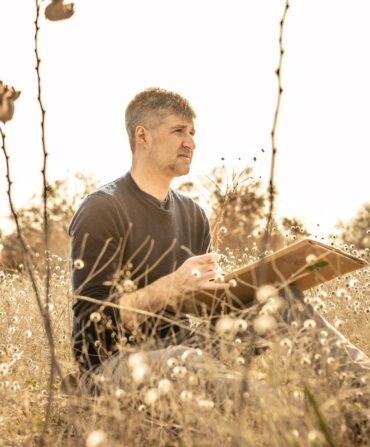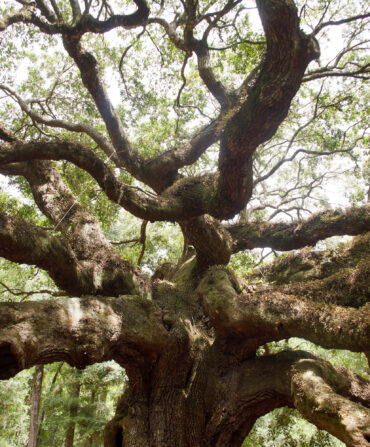Land & Conservation
Saving Grand Bahama’s Mangrove Forest
An unprecedented group effort seeks to restore what was lost after Hurricane Dorian—one mangrove at a time

Photo: Peter Frank Edwards
A handful of mangrove seedlings prior to transplanting.
I drive the dibble bar into the muck with one hand, push it forward a foot or so, then pull it back.
Working a dibble isn’t complicated, which is a good thing, because I didn’t know that such a thing as a dibble bar existed until a few minutes ago. The tool is essentially a specialized shovel that terminates in a flattened rectangular blade that can be rocked back and forth to create a perfectly sized wedge-shaped hole for planting small trees and shrubs. Like the hole I’ve just excavated.
I drop a red mangrove seedling into the black cranny and bend down to push sand and mud back into place, anchoring the eighteen-inch-tall seedling. That’s one down, I think, and a lot more to go. It’s up to time and tides to do the rest.
My small sense of accomplishment is fleeting, however. When I straighten up and gaze around, the scope and scale of the task at hand are overwhelming. I’m far out on a tidal flat at the mouth of Romer Creek, on the far eastern end of the East End of Grand Bahama, standing in a vast forest of dead mangroves. To the west, the Caribbean Sea unfurls in a postcard-worthy aquamarine sheet, but in every other direction lie mile upon mile of sun-bleached, desiccated, skeletal dead mangroves that cloak the shorelines and shroud the banks of tidal creeks.
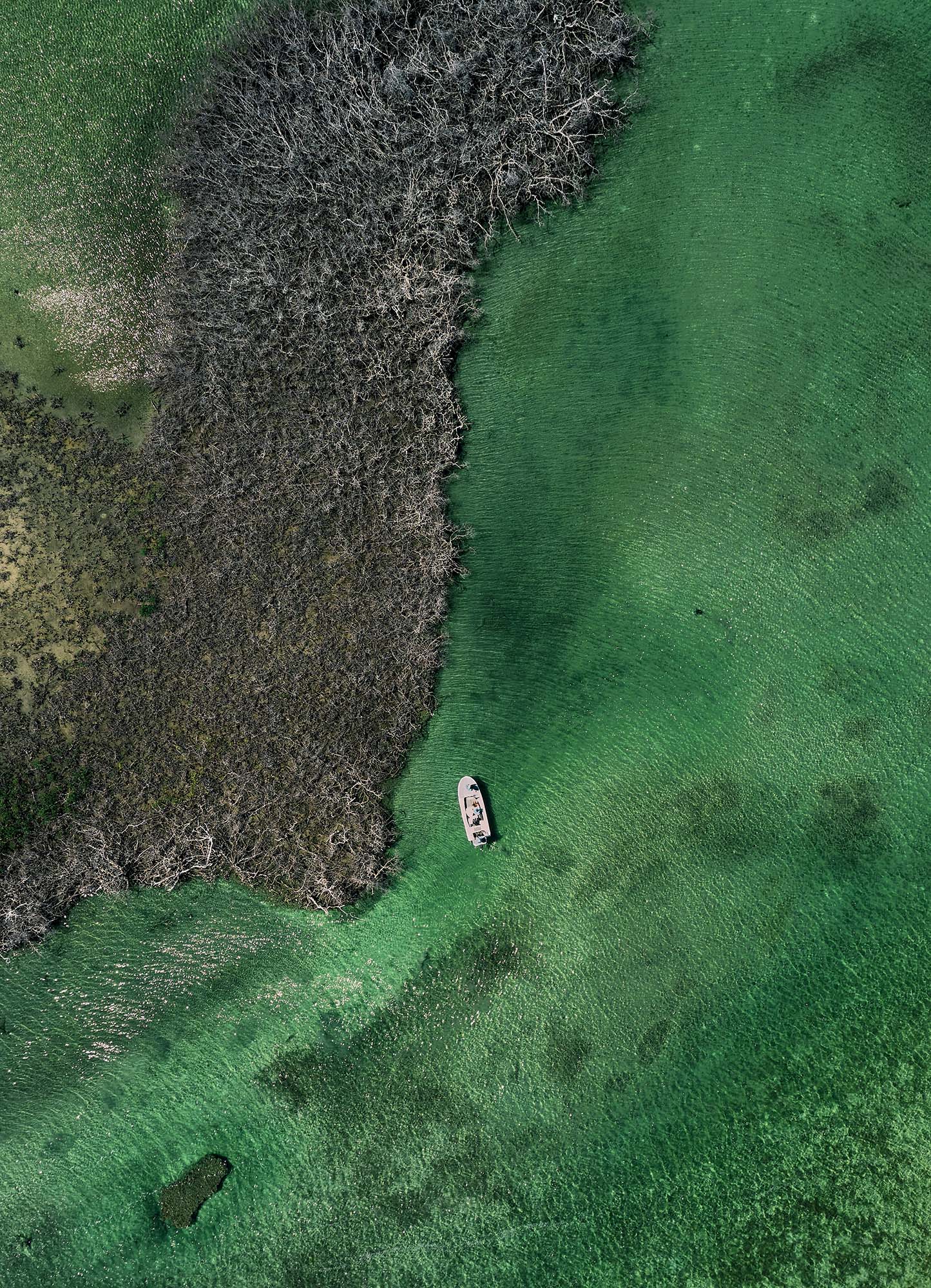
Photo: Peter Frank Edwards
A flats boat works the edge of a once-thriving mangrove shoreline for bonefish.
When Hurricane Dorian made landfall in the Bahamas on September 1, 2019, its 185-mile-per-hour winds made it the strongest storm ever to hit the archipelago. Dorian ravaged Marsh Harbour on Great Abaco Island, then crossed open water and stalled over the East End of Grand Bahama for more than twenty-four hours. There, the hurricane pushed an unprecedented twenty-foot storm surge over the small fishing settlements of McLean’s Town, High Rock, and Sweeting’s Cay. Some 60 percent of all of Grand Bahama Island, including Freeport, was under water. When the waters receded, the toll on human life, homes, and commercial buildings was staggering: The official estimate of lives lost stands at seventy-four, but scores more are still missing. Damage estimates soared to $3.4 billion.
The impacts were hardly limited to homes and highways. Soon enough the storm’s devastating effect on the vast mangrove forests that rim these islands became clear. Dorian destroyed 73 percent of the mangroves on Grand Bahama and nearly half the mangroves on the Abaco Islands. All told, the hurricane’s winds stripped sixty-nine square miles of mangroves of their leaves—more than forty-four thousand acres—then smothered them in salt water for days.
It’s a mind-boggling scene, but the visuals tell only part of the story. As I step through a snarl of dead mangroves and raise the dibble tool for another plunge, I hear peals of laughter, snippets of conversation, and grunts and groans that remind me I am not alone. Scattered along the shoreline is a crowd of some seventy-five volunteers, among them local bonefishing guides, staff from nonprofit organizations, government officials, and an entire high school biology class from Freeport’s Bishop Michael Eldon School. In a heroic restoration effort, the Miami-based Bonefish & Tarpon Trust (BTT), Bahamas National Trust, Abaco’s Friends of the Environment, and a West Palm Beach apparel company called MANG are working together to collect mangrove propagules—viviparous pods, which drop off the parent tree to ride tides and currents before finding purchase on a flat or along a tidal creek. They then raise them to seedlings, and replant destroyed mangrove forests by hand, one seedling at a time. This public planting endeavor on Grand Bahama is the first in the five-year-long Northern Bahamas Mangrove Restoration Project. When it’s completed, at least one hundred thousand mangroves will take root in the destroyed mangrove flats and creeks on Grand Bahama and the Abacos, giving the hurricane-flattened habitats a jump start on recovery.
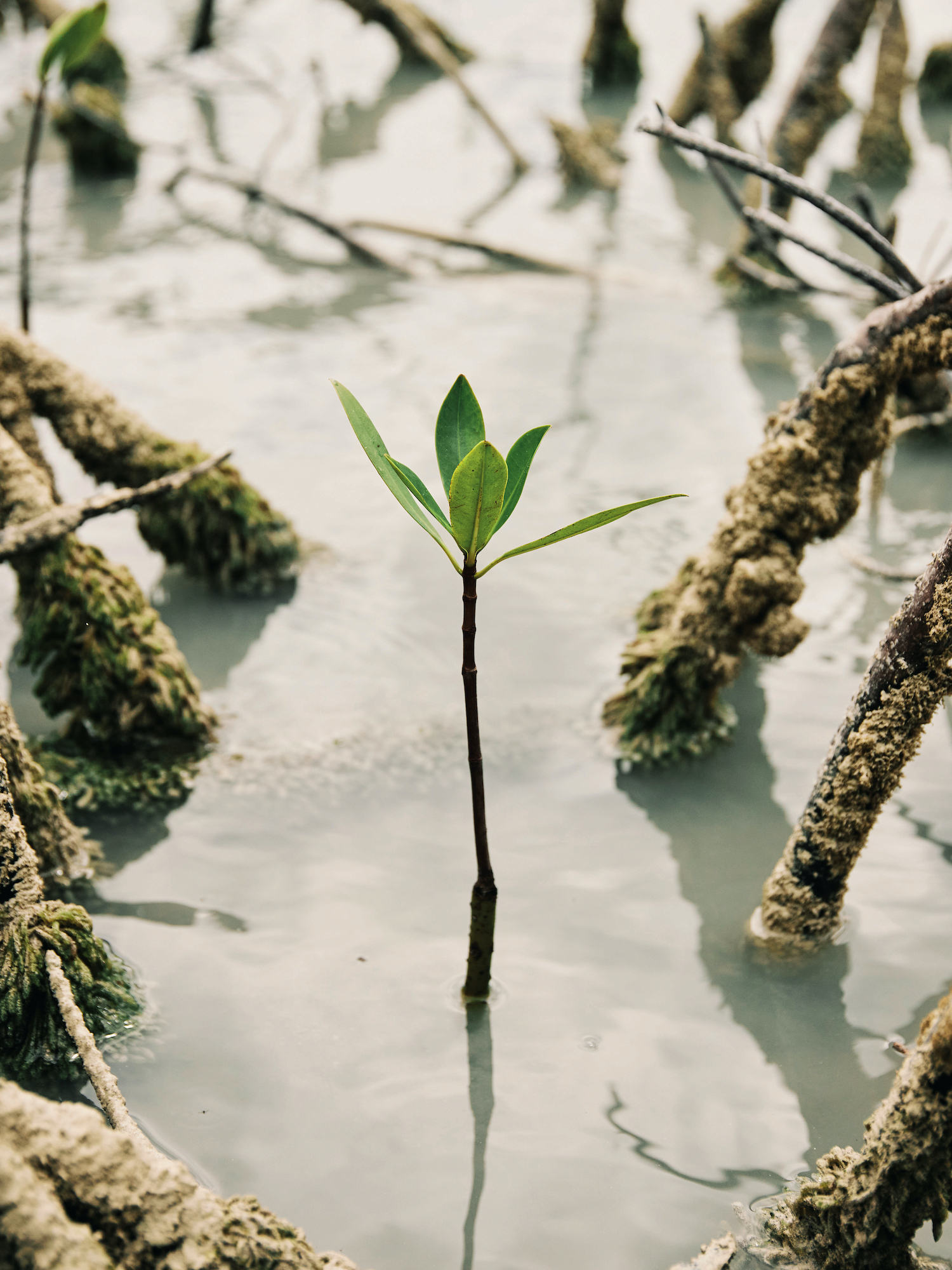
Photo: Peter Frank Edwards
A freshly planted seedling.
The storm, says Jim McDuffie, BTT’s CEO, “was far more than an ecological disaster. The mangroves held many Bahamian communities together, supporting an economic structure based on fishing that was the primary source of income for hundreds of families. With the mangroves gone, that entire structure is tattered.”
Which means there’s no time to waste. While the public at large hasn’t grasped the damage and the scale of the ecological destruction in this part of the Bahamas, nature itself is providing an insidious challenge to recovery. With every storm, large or small, a bit more ground is lost. Even the small creek channels are at risk, because they’ve lost their shield of mangroves. They will widen, and the erosion will worsen.
Unless the mangroves rebound. And for that, they will need a lot of helping hands.
Two days earlier, on an empty lot on the outskirts of Freeport, I stood in the middle of another thicket of mangroves—except each tree was barely a foot and a half tall. In the mottled shade of coconut palms, some three thousand mangrove seedlings grew in elevated troughs. It’s one of three mangrove nurseries that BTT oversees. Another is just a few miles away, and a third is sited on Great Abaco Island.
Justin Lewis, BTT’s Bahamas Initiative manager, shepherds these infant trees with zeal. He pulled a single mangrove seedling from a plastic trough to show me its young root system, which looked like the arms of a tiny octopus. When replanted in the wild, the tender, serpentine roots will ultimately grow into the signature exposed prop root systems of mangroves. The closely knit forests anchor sediments and shelter young fish, crabs, and shrimp. They buffer human communities from storms and sequester huge quantities of carbon—more, in fact, than any other forest type.
Mangroves have evolved to handle strong storms, but in the hurricane-ravaged shorelines that rim much of Grand Bahama and the Abacos, there aren’t enough living trees left to reseed the forests. Over the coming years, the standing thickets of dead mangroves will rot and fall. If they aren’t replaced, the fertile sediments that provide feeding grounds for bonefish, permit, and tarpon will gradually wash away in tides and storms, taking with them the storm protection that helped safeguard Bahamian settlements on the islands—and an irreplaceable economic engine. Flats fishing delivers $169 million per year in economic benefits to local communities and helps sustain roughly eight thousand Bahamians.
“The mangroves are our first line of defense,” explains Jewel Thompson-Beneby, science officer for the Bahamas National Trust. “With enough time, they can rebound on their own, but now we’re trending toward more frequent large storms. We see the enormous task in front of us, but we have to help our natural environment come back.”
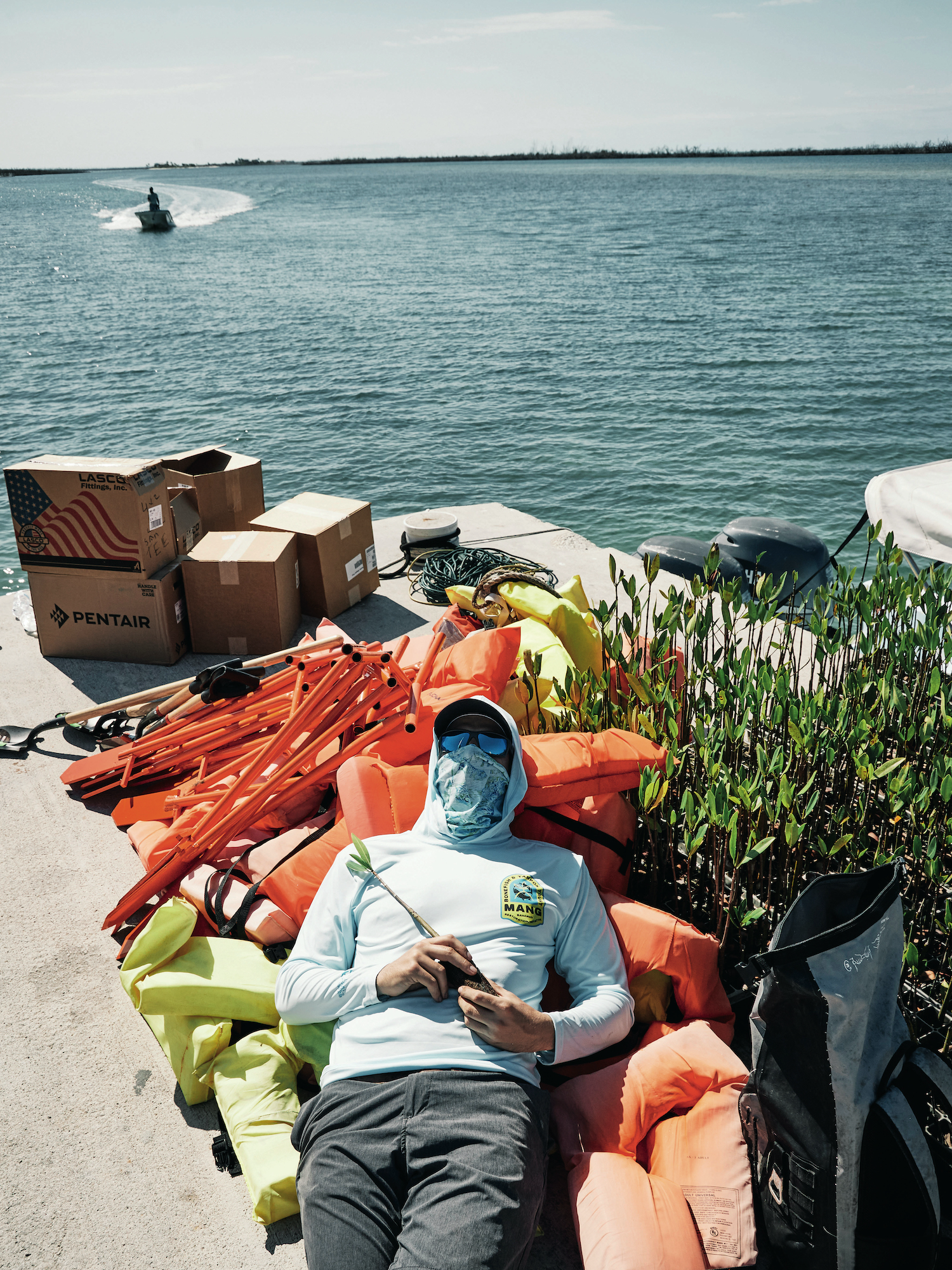
Photo: Peter Frank Edwards
Kyle Rossin of MANG catches a quick breather.

Photo: Peter Frank Edwards
Guide Leroy Glinton mans the wheel, ferrying a boatload of seedlings, while Justin Lewis of Bonefish & Tarpon Trust surveys from the bow.
The seeds of this mangrove project started soon after Dorian, when BTT asked Floridians to collect red mangrove propagules and deliver them to staging sites at tackle shops across South Florida. BTT also partnered with MANG, which the twin brothers Kyle and Keith Rossin founded in 2015 on the premise of planting one mangrove for every product sold. The company has flourished, and today MANG profits support an extensive horticulture program that nurtures mangrove seedlings for at least two years before sending them to restoration sites.
Together, MANG and BTT shipped a forty-foot container with 15,000 propagules and 7,500 seedlings to the Bahamas in November 2020. “That Florida effort was huge in getting us off the ground,” Lewis says. “It underscored the tight bonds between the mainland and the Bahamas, and between the U.S. angling community and the people of these islands.” Now the effort is shifting to train local Bahamians, from schoolchildren to bonefish guides, to collect the propagules and raise the seedlings. “The ultimate goal is for the effort to headquarter in the Bahamas,” says MANG’s Kyle Rossin. For starters, there is ecological value in using local plants for restoration. But there’s more. “Taking people out to plant the mangroves one by one is real restoration work. Much of the value of these projects is in education. There’s nothing like understanding the ecosystem around you to build community and capacity for action.”

Photo: Peter Frank Edwards
Anglers pose for a fish pic against a stark backdrop of dead mangroves.
Those efforts go beyond the occasional field trip. BTT and the Bahamas National Trust partnered to present a Flats Ecology Curriculum in Bahamian schools, getting kids out on the flats to net juvenile bonefish, study how mangroves hold shorelines fast, and explore conservation issues firsthand. “A lot of Bahamian kids have never been on a flat,” Lewis says. “They have no idea what a treasure they have in their own backyard.”
But some of the high school students who trek to these flats off Romer Creek do. Deep in the mangroves, Rachelle Manchester and Shakada Hutson are paired up and focused. They trade duties: One works a dibble while the other plants seedlings. All around, strung over a few hundred yards of shoreline, classmates ferry five-gallon buckets and containers of seedlings from boats anchored off the flats to dry ground, dig holes, and howl when a dried and shattered mangrove pokes their bare arms.
The two friends have taken part in environmental projects ever since the sixth grade. When Lewis visited the school to give a talk on the value and natural history of Bahamian flats, they immediately volunteered to intern for the mangrove restoration project. They harbor no illusions about the road ahead.
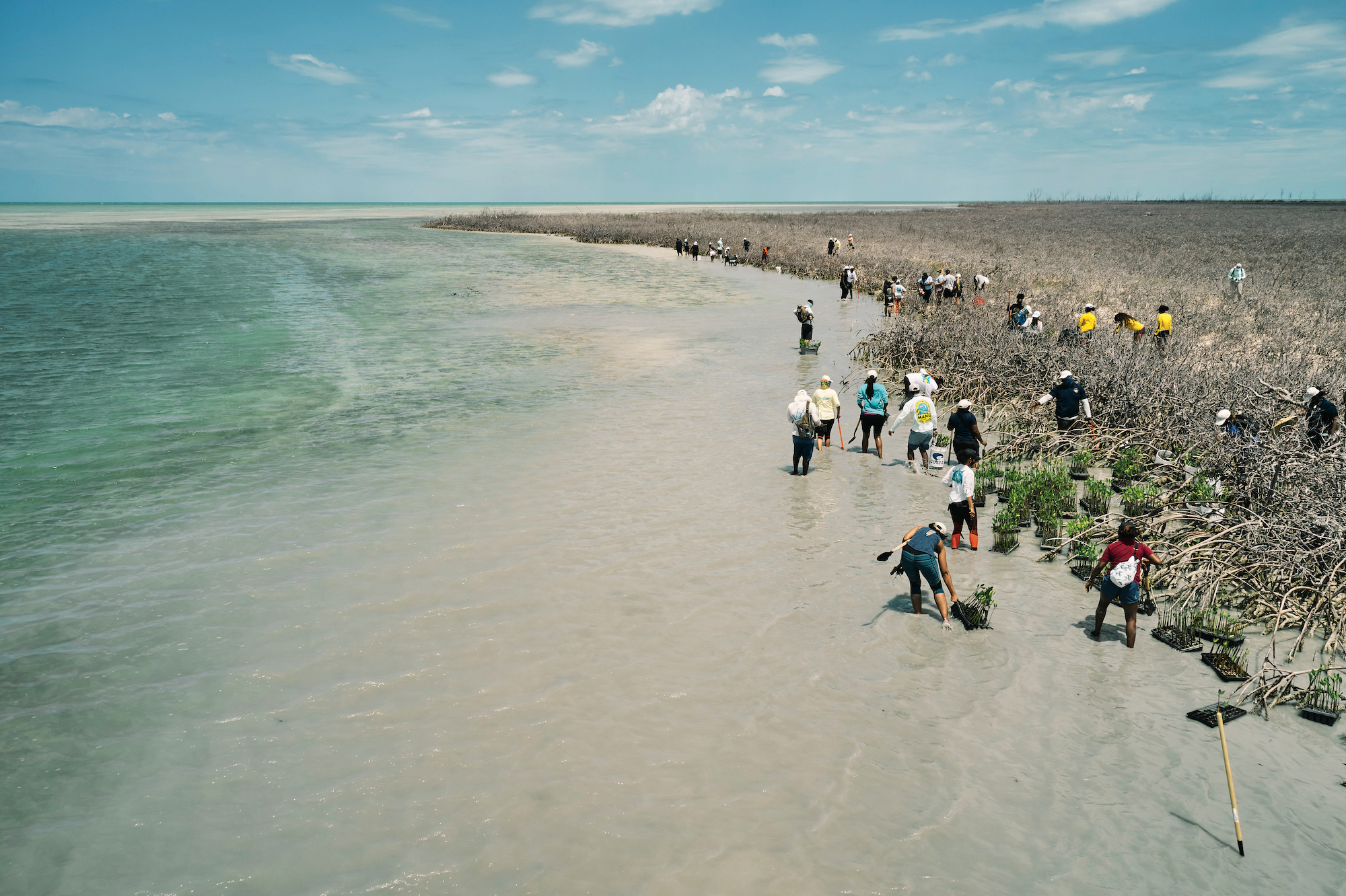
Photo: Peter Frank Edwards
Grand Bahama residents work through the heat of the morning.
“We know what these flats looked like, and what they should look like,” Manchester says, shoulders slumped with the weight of the bucket. “We work in the nurseries and help raise these seedlings, so it is devastating to see it like this now.”
Hutson nods in agreement. “This is a small step in a long journey, we know that,” she says. “But we have to give this ecosystem a fresh start. We know this can make a difference.”
By the end of the day, her determination will have played no small role in the project’s success: These volunteers will have planted 4,608 seedlings along one of the most exposed mangrove forest edges on Grand Bahama. The seedlings will grow and mature, and twice a day their own propagules will be carried far and wide and deep into the ghost mangroves. Each ablution will be a resurrection tide, using the dead to shelter the living, flooding the Bahamas flats with new green life.

Photo: Peter Frank Edwards
Volunteers Summer Sturrup (left) and Kaya Murray.
“Let me see a cast,” Walter Reckley instructs. He speaks in a measured tone, calm and reassuring. Reckley has guided bonefish anglers for thirty-four years out of the East End of Grand Bahama. He knows there’s only so much he can do from the poling platform of a skiff. The rest is up to the angler.
“Long cast,” he says. “Go.”
I see the trio of bonefish arrowing toward the boat, just at the edge of my casting range. I play line out, and with each false cast, Reckley directs the action.
“Cast,” he says.
Another backcast.
“Cast.”
I double-haul for the distance.
“Drop it.”
When the bonefish strikes the shrimp fly and feels the ruse of the hook, it streaks for the shoreline of mangroves in that sizzling run across the shallows that keeps anglers awake at night longing for a turn on the casting deck. The reel zings as the fish runs for sixty yards or better, then takes a ninety-degree turn around a single small mangrove in the water and bolts for another eighty-yard blitz. The mangrove dances as the line slithers around the sapling. With the added stress, the slightest move could break off the fish. I dial back the reel’s drag to lighten the load. Suddenly Reckley’s instructions are slightly more animated.
“Now let him run, man,” he says, through gritted teeth. “Do not touch the reel!”
He poles the skiff in pursuit until he can free the line from the mangrove. When the bonefish feels the leash slip, it races away again, fresh and strong, the fly line sizzling as it rips across the water.
Our morning on the flats is astonishing. My angling buddy and I trade fish after fish for nearly four hours. We can’t even take a break for lunch. As bonefish course across the flats, we split a pack of cheese crackers for a jolt of energy, and keep casting. Finally, at 1:30 in the afternoon, we lay down the rods long enough to choke down sandwiches. And we still have a solid afternoon of fishing in front of us.
Reckley guides at East End Lodge on Grand Bahama, which reopened March 14, months past its planned opening date due to pandemic difficulties. It was the first of the demolished Bahamas bonefishing lodges to come back to life. Even today, the famed Abaco Lodge remains closed, and its future is uncertain. Deep Water Cay, which opened in 1958 and is considered a spiritual center of bonefishing in the Bahamas, is closed. Independent guides that operated out of the small hamlet of McLean’s Town lost boats, motors, homes, and family members. At the time of my visit, the town still lay in near ruin, and only about a third of its roughly 150 residents had returned.
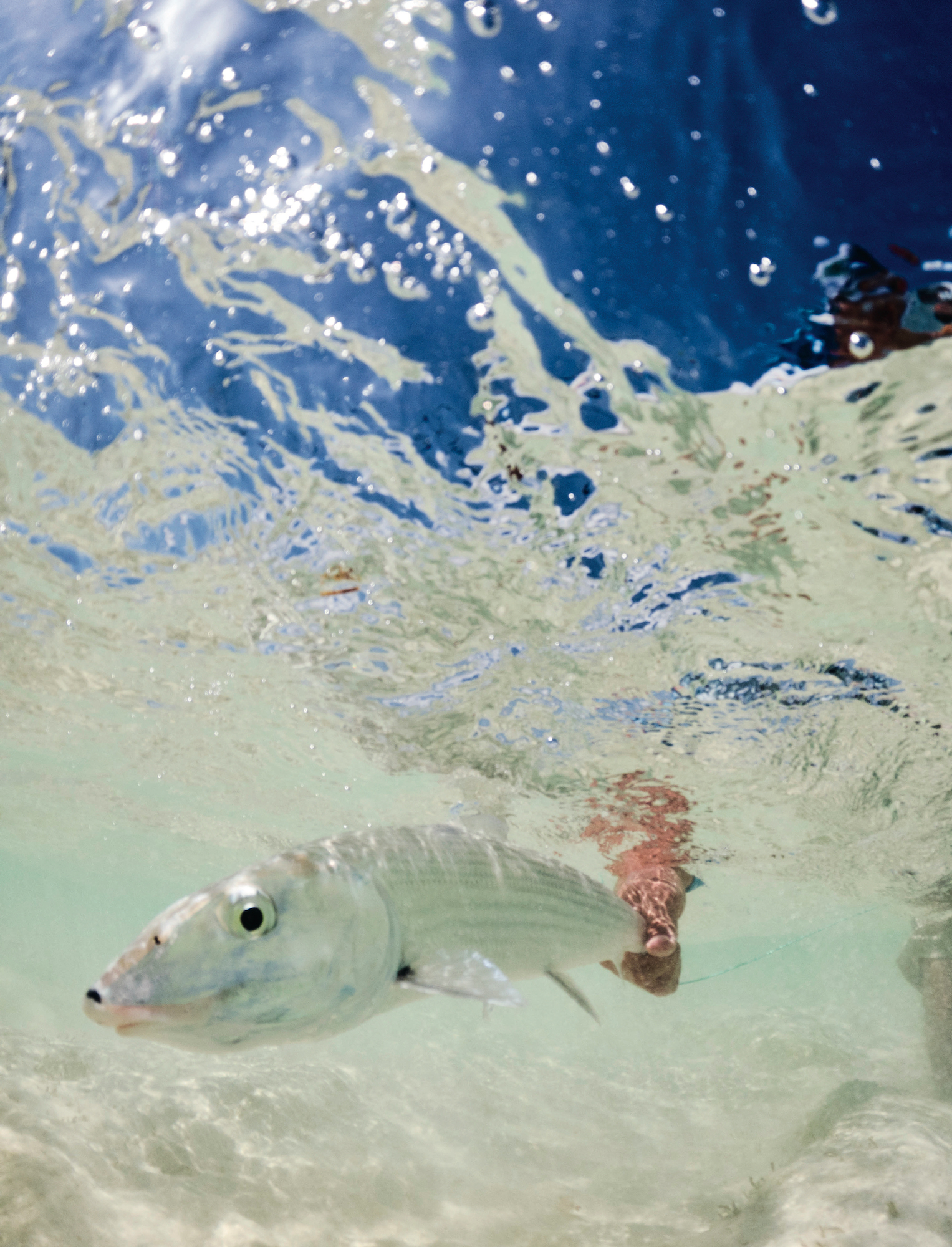
Photo: Peter Frank Edwards
A bonefish prior to release.
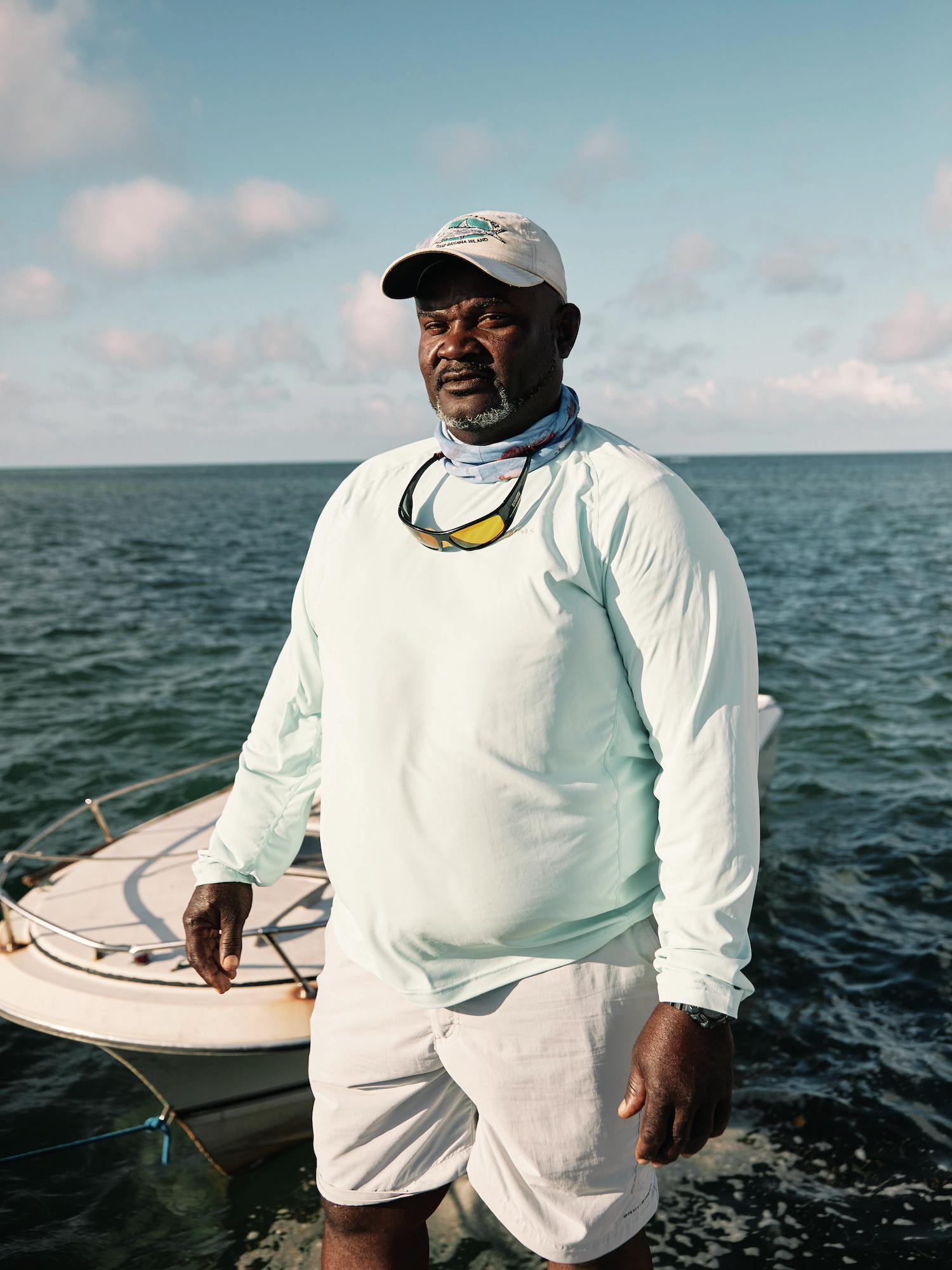
Photo: Peter Frank Edwards
Guide Walter Reckley of East End Lodge.
Across the Bahamas, and especially in the less settled regions such as McLean’s Town, a bonefishing lodge is its own economic ecosystem, a center around which communities, families of guides, lobster fishermen, outboard mechanics, and hospitality personnel orbit. Each lodge is a bastion of hope and a bulwark of opportunity far beyond a flats skiff.
East End Lodge owner Robert Neher watched Hurricane Dorian approach the Bahamas from an unexpected point of view. “I was on my first vacation in eight years,” he says, “sitting beside a pool with a towel over my head so I could see my phone. I watched the storm line up on this end of the island with two-hundred-mile-per-hour wind gusts, and all I could think was: This is my community. These are my friends.”
East End Lodge was crushed, but Neher’s thoughts first turned to supporting his employees and the intricate network of relationships built around the business. Within days, he kicked off a GoFundMe campaign that would ultimately raise and distribute $300,000 directly to his staff and McLean’s Town residents. All of his employees lost their homes. It would take a year before power would be restored to the East End. “People needed a lot of things,” he says, “and one thing they really needed was a job.”
“If we didn’t come back, the whole community is gone,” recalls Cecil Leathen, a longtime bonefishing guide and Neher’s partner at East End Lodge. “We have a lot of employees, and for the folks who are sixty and seventy years old, there was no hope for them. We have to do this for the town.”
Now that the lodge is open, anglers are returning, and with them some of the economic support that will lead to more recovery. In fact, one of the more curious aspects of these post-Dorian days is that the fishing around some of the most damaged portions of the island is very, very good. Part of that relates to a lack of fishing pressure, for sure: For more than a year on the East End, there were no bonefishing lodges to offer overnights and guides.
And the storm’s ferocity came with another thin silver lining for bonefish anglers: So much water swelled up and swept over the islands that it buffered the submerged meadows of turtle grass, manatee grass, and shoal grass on the flats from being scoured and scrubbed away. “We are very lucky that the underwater habitat is still intact,” Lewis explains. “The seagrasses came through the storm surprisingly well, and the fish are still very healthy.” The receding storm surge also dragged from the mangrove flats immense amounts of accumulated leaf litter and rich organic matter that have provided a nutritional jolt for flats and reef fish. How long that lasts is anyone’s guess. Without the intricate root systems of the mangroves holding the flats together, sediments will erode and possibly harm offshore reefs. Shorelines will retreat, and with them will go protection of inland and coastal settlements.
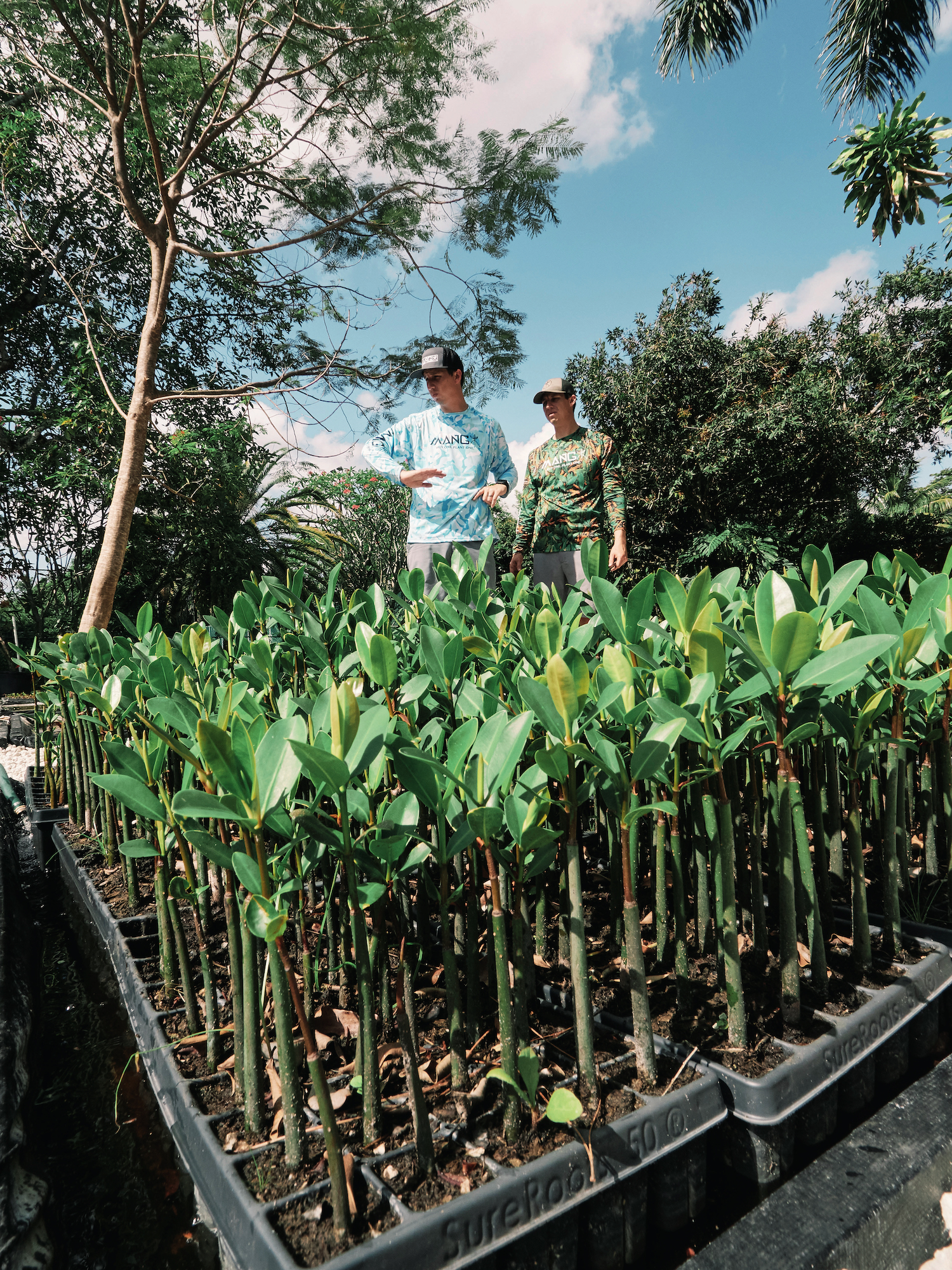
Photo: Peter Frank Edwards
Brothers Keith (left) and Kyle Rossin at the mangrove nursery in West Palm Beach.
“Everything in this ecosystem is connected to these mangroves,” Keith Rossin says. “A mangrove leaf falls into the water and kicks off a chain reaction of life support. Bacteria grow on the leaf, and the bacteria feed the zooplankton that then feed the little fish. And the little fish feed the bigger fish, and it goes on from there. What happens here in the mangroves matters all the way to the offshore reefs.”
All of which makes the effort to plant mangroves a critical task, no matter how Sisyphean it might appear. It is a symbiotic relationship, one nourished by the lush, who-knows-how-old mangrove forests that have long rimmed these islands. They are equal parts suit of armor and capillary system, a conduit through which life flows and connects every element of Bahamian culture.
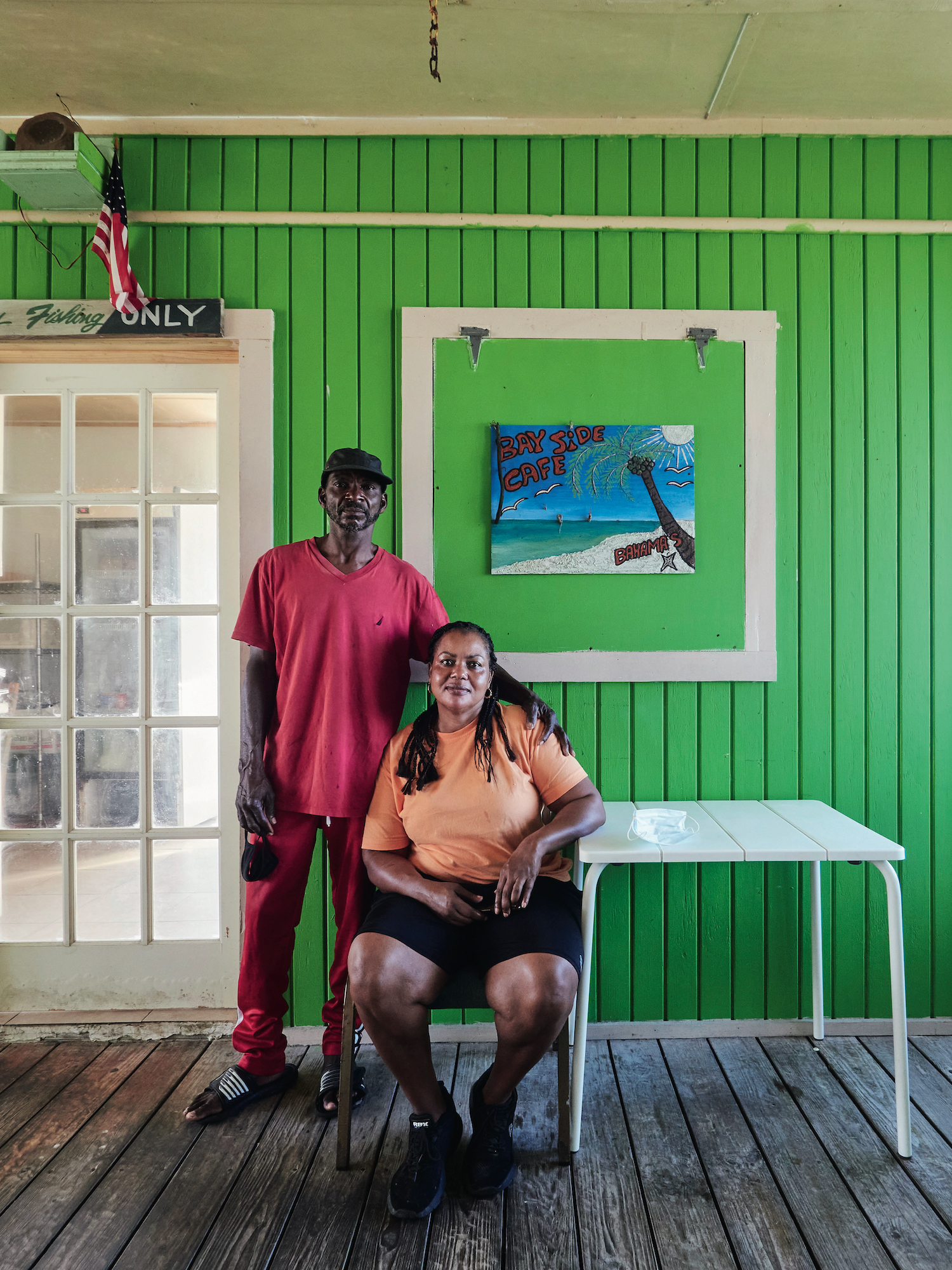
Photo: Peter Frank Edwards
Guide Joseph Thomas with his wife, Evelyn, at their restaurant Bay Side Café in McLean’s Town
In the five months since that first community planting on Romer Creek, the Northern Bahamas Mangrove Restoration Project has held planting events elsewhere on Grand Bahama and in the Marls of Abaco. Nearly twelve thousand seedlings have been placed, one at a time, by hand, into the sands of the Bahamas’ most devastated shorelines, under the grueling conditions of post-hurricane privations and the travel strictures of a worldwide pandemic. There has been impressive progress, but the scale of what needs to happen can seem crushing. Perhaps it’s a good thing that the work is so highly personal, and so intensely focused. You rock the dibble. You plant the seedling. You move three feet, and dig another hole. When you straighten your back and look around and see how little you have done, the only solace is to bend to the task, and plant another.
A few weeks prior to the public planting on Romer Creek, Livingston Tate, a longtime guide for Deep Water Cay and the North Riding Point lodge, traveled with BTT’s Lewis for a test planting of mangrove seedlings on an even more remote flat. Tate was born on Sweeting’s Cay, which is reachable only by boat and took Dorian’s fury on the chin. He’d volunteered his time and his boating skills to ferry seedlings from the docks at McLean’s Town to the work site on Romer Creek, and as we motored through the winding waterway, he recalled a return trip he’d recently made to that original test plot on the farthest margin of Grand Bahama.
“We worked that day in the mud, man,” he said. “We worked and we sweat and I left there and I still didn’t know it would do any good. So later, I went back on my own, to see. I didn’t take what other people said. I went there to take my own word.”
The motor groaned with the extra weight of the mangroves and a dozen students. Tate recalled driving a skiff out to the flats, where the small green seedlings still held fast to the sands.
“When I first saw what the storm did, it was like, Lord, is there ever going to be a way to come back from this? Now there is hope.” He pounded a broad hand against his chest. “I saw that day, that this can work.”
He choked up, and turned his attention back to the boat and its course through the mangroves.
“We can’t do this by ourselves,” he said, “but we can do this.” His voice trailed off again, and as he maneuvered the skiff through the mouth of a narrow creek, the limbs of gray dead mangroves were nearly close enough to touch. Suddenly we were in open water, with green turtle grass under the hull, the horizon blue and endless, and he pushed the throttle down and steered the skiff toward hope.



